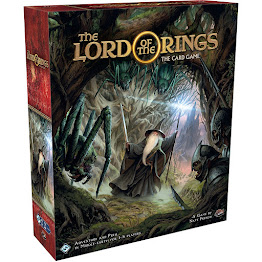Today's review is of the 2011 release, The Lord of the Rings: The Card Game. Also called Lord of the Rings Living Card Game. Or LOTR LCG for short. For 1-4 players, it takes 30 minutes per player. This review is based on playing the revised core set, released in 2022.
Overview
From the Learn to Play booklet, LOTR LCG "is
a game of heroes, perilous journeys, and
adventure set in the lands described in the epic
fantasy masterpiece created by J.R.R. Tolkien,
The Lord of the Rings. During this game,
players assume the role of a party of heroes
who are attempting to complete dangerous
quests." Your goal is to complete the quest or scenario (represented in stages by a series of cards) before your threat dial reaches 50. A cooperative game, only one player must complete the quest for all to be victorious.
To start, each player has their own deck (50-card minimum) with 3 starting heroes. Place the heroes on the table in front of you in the 'ready' state (characters 'exhaust' when used for an action like questing, defending, and attacking), add up their total threat cost and set your threat dial to that starting number (somewhere between 24-35, probably), and draw 6 cards. Players collectively choose the scenario upon which to embark. The corresponding card labeled 1A tells players which cards to use to build the encounter deck, which contains enemies, treachery, and locations they players will encounter throughout the game. Follow the instructions on the 1A card for both threat deck construction and any other initial conditions, flip it over to 1B, choose a first player, and you're ready to begin the first round.
Each game round consists of the following
seven phases, simplified here:
- Resource
- Place 1 resource token on each of your heroes and draw 1 card.
- Planning
- Spend your resource tokens to play allies, attachments, or other things to aid your heroes and bolster your side.
- Quest
- Choose character(s) to attempt to make progress on the current quest (1B to start). Any character(s) chosen are exhausted (tapped or turned sideways).
- Place 1 card per player from the encounter deck into the staging area.
- Each character has a willpower value; if the total value exceeds the shadow's total threat value in the staging area, advance the quest (or location if present) by placing progress tokens on it equal to the difference. If the progress tokens meets or exceeds the value on the quest, you advance to the next stage (2A comes after 1B, for example. Most quests end at 3B) and follow any instructions on that new card.
- Travel
- If there is no active location, you can choose to move 1 location in the staging area (making it active) next to the active quest. this reduces threat in the staging area (making the Quest phase easier), but also is an impediment, as you must place progress tokens on the active location before you can do so on the active quest (see prior step).
- Encounter
- Enemy characters in the staging area, one at a time, can enter a given player's area to engage a given player's characters. This can be done voluntarily or is forced by game conditions.
- Combat
- Enemy characters attack, one at a time, the player to which they are engaged.
- Players choose one (or zero) characters to defend a given attack. Exhaust them. Characters may take damage.
- Once all enemies have attacked, players then choose one (or more) characters to attack a given enemy. Characters exhaust to attack.
- Refresh Phase
- Ready all exhausted characters, increase each player's threat dial by 1, and pass First Player clockwise. Begin the next round.
 |
| The play area for one player, taken from the Learn to Play book |
Play continues until one or more players win (defeat the final stage in the quest) or everyone loses (reaches 50 threat).
Review
I like this game. It's a typical Fantasy Flight offering, meaning there is good production quality, interesting decisions, and thoughtful rules. It may seem like a lot to take in at first, but it is easy to get the hang of, and after a few rounds, it flies by.
I played 4-5 solo games- and won only once. This game is hard. But I used the preconstructed starter decks, each of which featured only one 'faction'. Each has their specialty, and successful decks will mix two or more factions (there are four) to leverage different strengths and increase likelihood of success.
This is a "living card game," meaning more cards are released in defined packs (so there is no randomness; you know what you'll get). The game has been going strong for 11 years, and the revised core set indicates they have a lot more planned. In addition to the main Fantasy Flight website, here are a handful of resources I found helpful as I navigated the game, rules, and releases:
Hall of Beorn- a great site to search for individual cards or view cards by expansion.
Tales from the Cards, Cardboard Clash, or Vision of the Palantir- sites with opinions on which sets to buy if you're new and exploring the game.
Rating: A


No comments:
Post a Comment